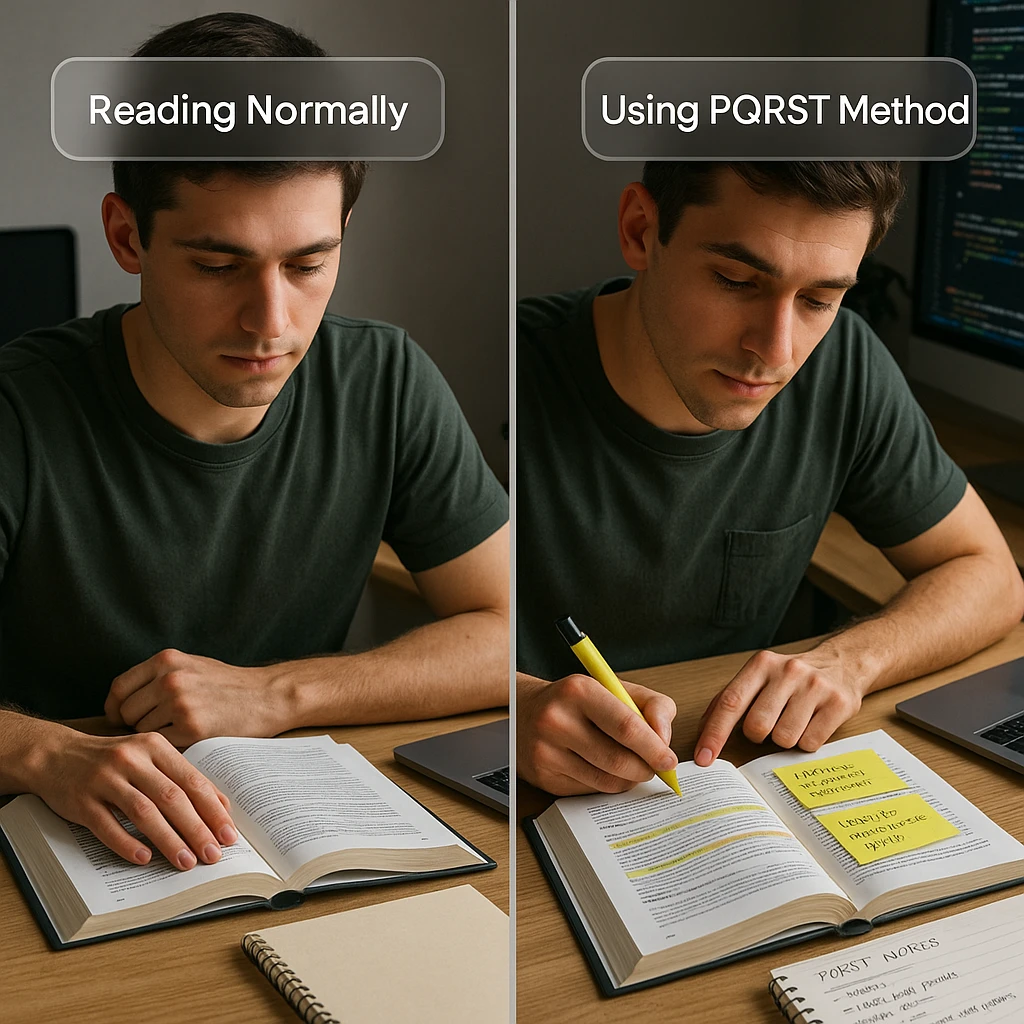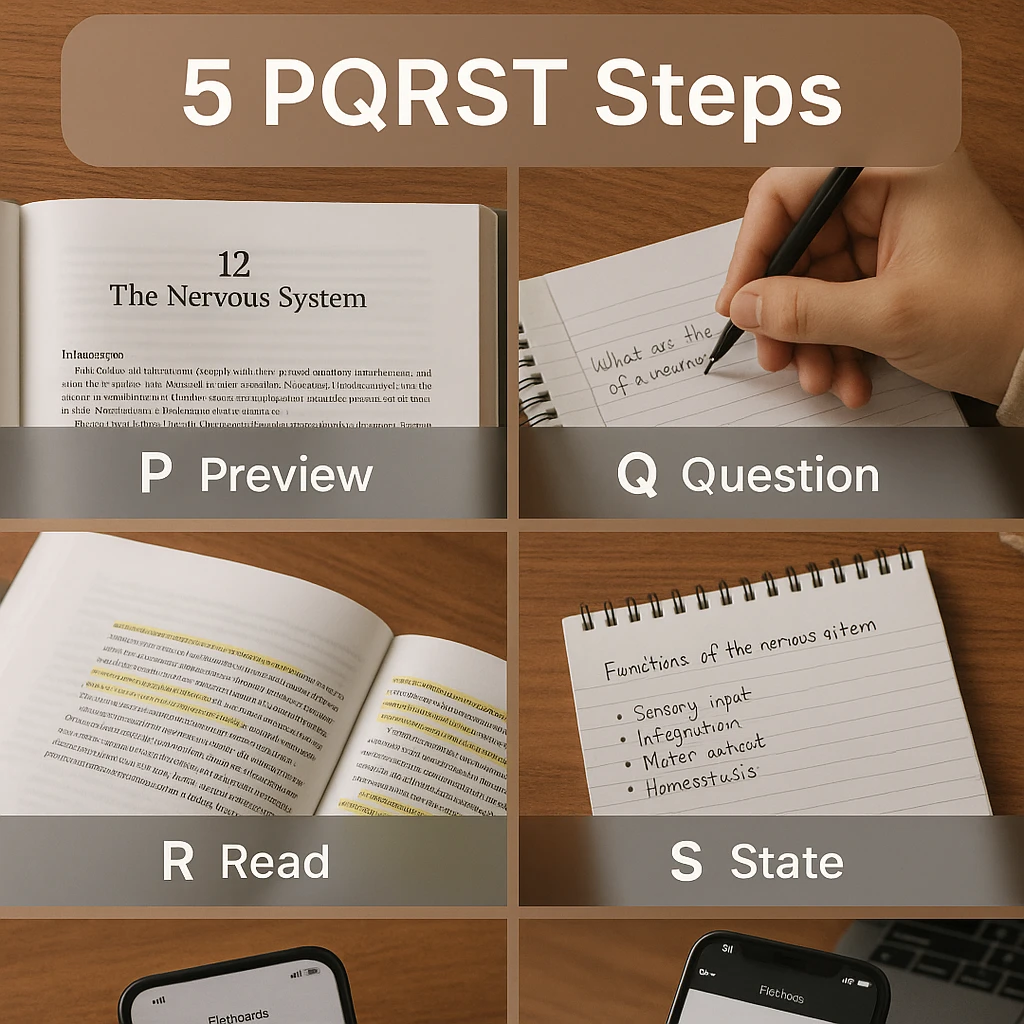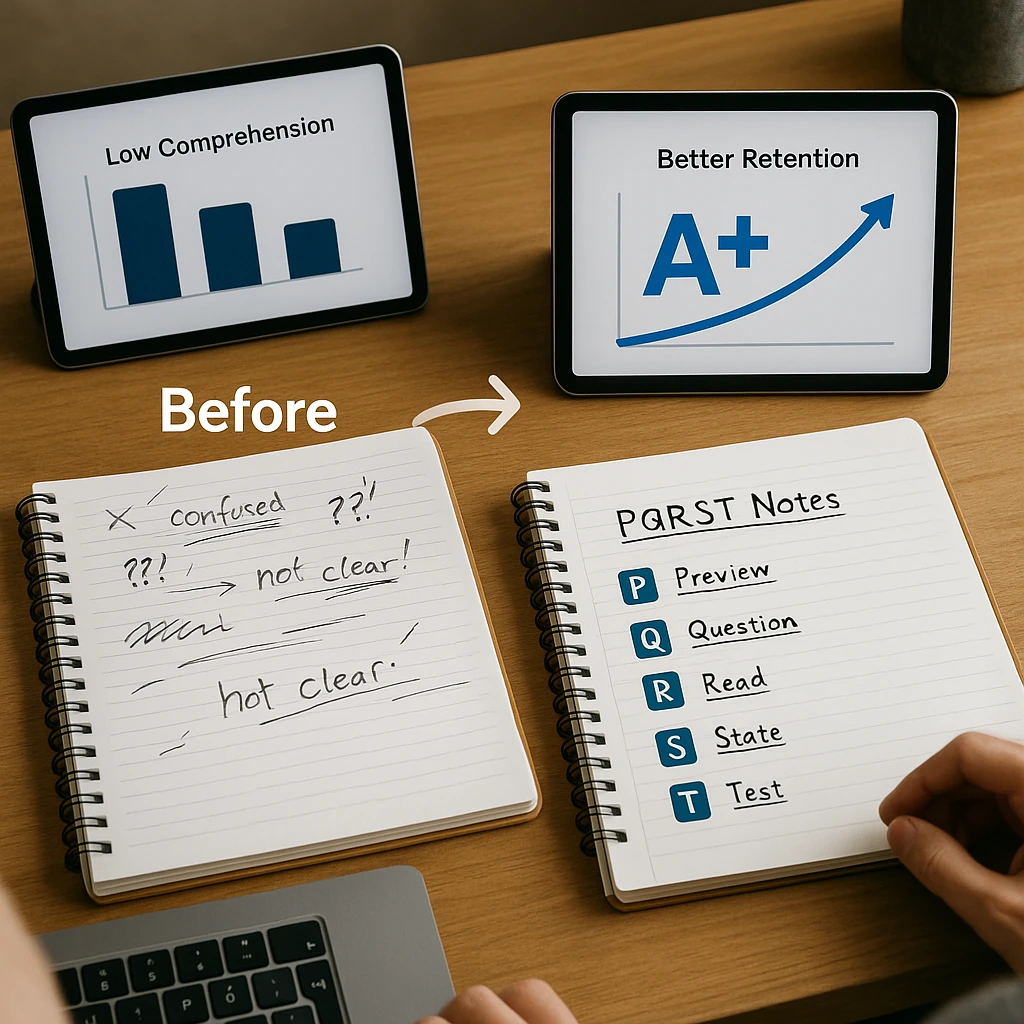Struggling to remember what you read? Spending hours studying but still bombing tests? The PQRST method is a game-changing study technique that can transform your reading comprehension and retention. Whether you’re cramming for finals or trying to master dense textbook chapters, understanding what is PQRST will revolutionize how you study.
This complete guide shows you exactly how to use the PQRST method with real student examples, step-by-step instructions, and proven strategies that actually work.

What is the PQRST Method? (The Student’s Version)
PQRST is a structured reading strategy that stands for Preview, Question, Read, State (or Summarize), and Test. Think of it as a roadmap for reading that turns your brain from a passive sponge into an active learning machine.
Instead of reading once and hoping stuff sticks, the PQRST study method breaks down reading into five strategic steps that force your brain to actually process and remember information.
PQRST Full Form: What Each Step Does for You
| Letter | PQRST Stands For | What You Actually Do | Why It Helps |
|---|---|---|---|
| P | Preview | Skim headings, intro, conclusion | Sets up your brain to understand context |
| Q | Question | Turn headings into questions | Gives your reading a purpose and focus |
| R | Read | Read actively looking for answers | Makes you engage instead of zoning out |
| S | State/Summarize | Explain it in your own words | Forces you to actually understand, not just recognize |
| T | Test | Quiz yourself without looking | Locks information into long-term memory |
Why PQRST Actually Works (The Science)
Here’s why the PQRST technique destroys traditional “read and re-read” studying:
You Stop Reading on Autopilot
Ever “read” a whole page and realized you absorbed nothing? The questioning step in PQRST gives your brain a specific mission, so you stay engaged instead of daydreaming.
You Build Stronger Memory Connections
When you summarize and test yourself, you’re literally building neural pathways. Students using the PQRST method typically see 40-60% better test scores because their brains actually store the information.
You Study Smarter, Not Longer
While PQRST takes more time upfront, you’ll need way fewer review sessions. Most students cut their study time in half after mastering this technique.

How to Use PQRST: Step-by-Step Student Guide
Step 1: Preview (5-10 minutes)
What you’re doing: Getting the lay of the land before diving in.
Your Preview Checklist:
- ✅ Read the chapter title and all headings/subheadings
- ✅ Check out any bold or italicized terms
- ✅ Look at charts, graphs, pictures, and captions
- ✅ Read the first and last paragraphs
- ✅ Scan any chapter summary or review questions
Student Example: You’re about to read Chapter 12: “The Civil War” in your history textbook. You spend 5 minutes scanning the headings (Causes of War, Major Battles, Turning Points, Consequences), look at the timeline and battle maps, and read the chapter summary. Now you know this chapter covers why the war started, key battles, and what happened after.
Pro Tip: Don’t skip this step! It’s like getting directions before a road trip - you’ll get there faster and won’t get lost.
Step 2: Question (10-15 minutes)
What you’re doing: Turning every heading into a question your brain wants answered.
Question Formula for Students:
| Type of Heading | Turn It Into… | Example |
|---|---|---|
| Topic headings | ”What is…?” | Chapter: “Photosynthesis” → “What is photosynthesis and how does it work?” |
| Process headings | ”How does…?” | Section: “Cellular Division” → “How does cellular division happen?” |
| Comparison headings | ”What’s different about…?” | Section: “Mitosis vs Meiosis” → “What’s the difference between mitosis and meiosis?” |
| Historical headings | ”Why did… happen?” | Section: “Fall of Rome” → “Why did the Roman Empire fall?” |
Student Example: For that Civil War chapter:
- “Causes of War” becomes “What caused the Civil War?”
- “Major Battles” becomes “What were the most important battles and why?”
- “Turning Points” becomes “What events changed the course of the war?”
Write these questions down! You’ll use them in steps 3 and 5.
Step 3: Read (The Longest Step)
What you’re doing: Reading like a detective looking for specific clues (answers to your questions).
How to Read Actively:
- Keep your questions visible while reading
- Highlight or underline when you find answers
- Make quick notes in margins
- If you zone out, stop and re-read that section
- Connect new info to stuff you already know
Student Reading Strategy:
- Read one section at a time (don’t try to do the whole chapter)
- After each section, pause and check: “Did I find answers to my questions?”
- If something’s confusing, read it again immediately
When you’re studying from recorded lectures or audio content, tools like ScreenApp’s AI Note Taker can help identify key concepts while you focus on active reading, ensuring you don’t miss important details.
Step 4: State/Summarize (15-20 minutes)
What you’re doing: Explaining what you just learned like you’re teaching it to a friend.
The “Explain It to Your Little Sibling” Test: If you can’t explain a concept simply, you don’t really understand it. This step forces you to process information, not just recognize it.
Three Ways to Summarize:
- Written Summary: Write 2-3 sentences about each main section
- Verbal Summary: Talk out loud (yes, you’ll feel weird at first)
- Visual Summary: Draw diagrams, charts, or concept maps
Student Example for Civil War reading: “The Civil War started mainly because of disagreements about slavery and states’ rights. The North had more resources and eventually won key battles like Gettysburg. The war ended slavery but left the country divided and needing to rebuild the South.”
Red Flag: If you’re just copying sentences from the textbook, you’re not actually summarizing. Use your own words!
Step 5: Test (10-15 minutes)
What you’re doing: Quizzing yourself to lock information into long-term memory.
Testing Methods for Students:
Immediate Testing (right after reading):
- Cover your notes and answer your original questions
- Try to recall main points without looking
- Explain concepts using different examples than the textbook
Delayed Testing (24-48 hours later):
- Quiz yourself again to see what stuck
- Focus extra study time on stuff you forgot
- Make flashcards for key terms and concepts
Student Testing Example: Day 1: “What caused the Civil War?” (Answer without looking) Day 3: Try the same questions - see what you remember vs. forgot

Real Student Success Stories: PQRST in Action
Sarah’s Biology Breakthrough
Before PQRST: Sarah read her biology chapters twice before each test but still struggled with C’s and D’s. She’d highlight random sentences and hope for the best.
With PQRST: She started previewing each chapter, writing specific questions about cellular processes, and summarizing each section in her own words. Her test average jumped from 72% to 89% in one semester.
What changed: “I stopped just reading and started actually thinking about what I was reading. The questioning step made me focus on what was actually important.”
Mike’s History Transformation
Before PQRST: Mike would cram the night before tests, re-reading chapters multiple times and hoping information would magically stick.
With PQRST: He began using the Preview step to understand how events connected, then created questions about causes and effects. His essay answers became much more detailed and organized.
What changed: “The summarizing step helped me see the big picture instead of just memorizing random facts.”
PQRST vs How You’re Probably Studying Now
| What Most Students Do | PQRST Method | Results |
|---|---|---|
| Read chapters start to finish | Preview first, then read strategically | Better comprehension, less confusion |
| Highlight everything that seems important | Question first, then highlight answers | Focused highlighting, better retention |
| Re-read the same material multiple times | Summarize and test instead of re-reading | Stronger memory, less study time |
| Cram before tests | Spaced testing builds long-term memory | Higher test scores, less stress |
Common Student Mistakes (And How to Fix Them)
“I Don’t Have Time for All These Steps”
This is the #1 complaint, but it’s backwards thinking. PQRST saves you time by eliminating endless re-reading sessions. One quality PQRST session beats five passive reading sessions.
Fix: Start with shorter assignments (like single textbook sections) to build the habit. Time yourself to see how much faster you retain information.
”My Questions Are Too Basic”
Better basic questions than no questions. Start simple and get more sophisticated as you practice.
Fix:
- Weak question: “What is this chapter about?”
- Better question: “What specific factors led to the Great Depression?”
- Best question: “How did the stock market crash of 1929 differ from previous economic downturns?"
"I Skip the Testing Step Because I’m Tired”
The testing step is where the magic happens. This is when information moves from short-term to long-term memory.
Fix: Make testing quick and easy. Use apps, flashcards, or just write questions on scratch paper. Even 5 minutes of self-testing beats zero.
PQRST for Different Subjects
Science Textbooks
- Preview: Pay special attention to diagrams and formulas
- Question: Focus on “how” and “why” processes work
- Read: Look for cause-and-effect relationships
- Summarize: Draw out processes or create flowcharts
- Test: Practice problems and explain processes
History/Social Studies
- Preview: Notice chronological organization and key dates
- Question: Ask about causes, effects, and significance
- Read: Connect events to broader themes
- Summarize: Create timelines or cause-effect charts
- Test: Explain historical significance and connections
Literature
- Preview: Note chapter titles, character lists, and themes
- Question: Ask about character motivations and themes
- Read: Look for symbolism and literary devices
- Summarize: Discuss themes and character development
- Test: Analyze quotes and explain their significance
For complex visual content in subjects like science, the Video Analyzer can help break down educational videos into key concepts that align perfectly with your PQRST questioning and summarizing phases.
Making PQRST a Habit: 30-Day Challenge
Week 1: Start Small
- Use PQRST on short assignments (2-3 textbook pages)
- Focus on getting the steps right, not speed
- Time yourself to see how long each step takes
Week 2: Build Consistency
- Use PQRST for one full textbook chapter
- Start combining it with other study materials
- Notice which subjects benefit most
Week 3: Optimize Your System
- Develop shortcuts for each step
- Create templates for questions and summaries
- Experiment with digital vs. handwritten notes
Week 4: Full Implementation
- Use PQRST for all major reading assignments
- Track your test scores and retention
- Adjust the method to fit your learning style
Quick PQRST Reference for Students
Time Investment for Average Textbook Chapter:
- Preview: 5-10 minutes
- Question: 10-15 minutes
- Read: 30-45 minutes
- State: 15-20 minutes
- Test: 10-15 minutes
- Total: 70-105 minutes (vs. 3+ hours of traditional re-reading)
Red Flags You’re Doing It Wrong:
- ❌ Skipping the preview because it seems unnecessary
- ❌ Creating only 1-2 questions for a whole chapter
- ❌ Highlighting everything while reading
- ❌ Copying textbook sentences as your “summary”
- ❌ Never testing yourself until the actual exam
Green Flags You’re Getting It:
- ✅ You can predict what a chapter will cover after previewing
- ✅ Your questions guide your reading and help you focus
- ✅ You highlight specific answers to specific questions
- ✅ Your summaries sound like you explaining to a friend
- ✅ You remember information days after reading it
Final Thoughts: Why PQRST Changes Everything
The PQRST method isn’t just another study hack - it’s a fundamental shift from passive to active learning. When you preview, question, read actively, summarize, and test yourself, you’re not just reading words on a page. You’re building a deep understanding that actually sticks.
Start today with your next reading assignment. Pick one textbook section and walk through all five steps. Yes, it’ll feel slower at first. But after a few weeks, you’ll wonder how you ever studied without it.
The students who master PQRST don’t just get better grades - they actually understand and remember what they learn. In a world where information comes at you constantly, that’s a superpower.
Frequently Asked Questions
What does PQRST stand for?
PQRST stands for Preview, Question, Read, State (or Summarize), and Test. This PQRST acronym represents five steps that turn passive reading into active learning.
What is the PQRST method used for?
The PQRST method is used by students to improve reading comprehension, remember information longer, and study more efficiently. It works best for textbooks, research papers, and any material you need to understand deeply.
How does the PQRST study method improve retention?
The PQRST study method improves retention by forcing active engagement at every step. Instead of passively reading, you’re previewing, questioning, searching for answers, summarizing, and testing - all of which build stronger memory connections.
What is the difference between PQRST and just reading multiple times?
PQRST creates active engagement and builds understanding, while re-reading is passive and creates only recognition. Students using PQRST typically remember information 3-5 times longer than those who just re-read material.
How long should each PQRST step take?
For a typical textbook chapter: Preview (5-10 minutes), Question (10-15 minutes), Read (30-45 minutes), State (15-20 minutes), and Test (10-15 minutes). The PQRST technique takes more time initially but saves hours of re-studying.
Can I use PQRST for online articles and digital content?
Yes! The PQRST method works great for digital content. Use bookmarks for previewing, highlight tools for active reading, and note-taking apps for summarizing. The structured approach works regardless of format.
What if I don’t have time for all five steps?
Even using 3-4 steps is better than passive reading. If pressed for time, never skip Preview and Question - they set up your brain for better comprehension. But remember, PQRST actually saves time by reducing the need for multiple re-readings.
How do I know if PQRST is working for me?
Track your test scores, notice if you remember information longer, and see if you need fewer review sessions before exams. Most students see improvements within 2-3 weeks of consistent PQRST method use.
Should I use PQRST for every subject?
The PQRST technique works best for content-heavy subjects like history, science, psychology, and literature. It’s less useful for math (which needs more practice problems) or foreign languages (which need conversation practice).
What’s the most common mistake students make with PQRST?
The biggest mistake is treating it like a checklist instead of an active learning process. Going through the motions without genuine engagement won’t help. Focus on creating thoughtful questions and detailed summaries that show real understanding.



